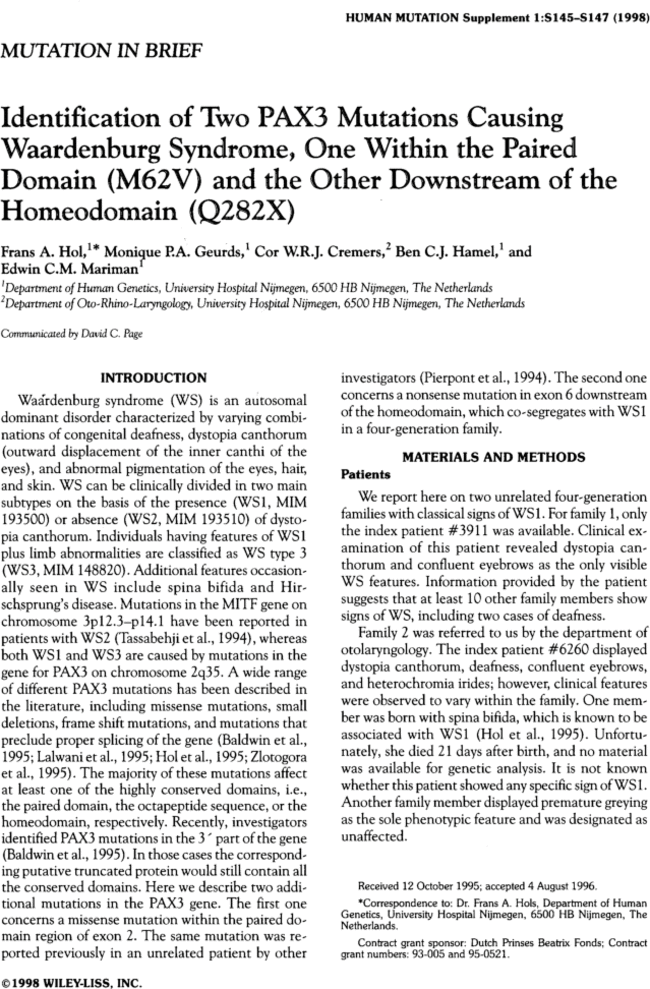Identification of two PAX3 mutations causing waardenburg syndrome, one within the paired domain (M62V) and the other downstream of the homeodomain (Q282X)
Corresponding Author
Dr. Frans A. Hol
Department of Human Genetics, University Hospital Nijmegen, 6500 HB Nijmegen, The Netherlands
Department of Human Genetics, University Hospital Nijmegen, 6500 HB Nijmegen, The NetherlandsSearch for more papers by this authorMonique P.A. Geurds
Department of Human Genetics, University Hospital Nijmegen, 6500 HB Nijmegen, The Netherlands
Search for more papers by this authorCor W.R.J. Cremers
Department of Oto-Rhino-Laryngology, University Hospital Nijmegen, 6500 HB Nijmegen, The Netherlands
Search for more papers by this authorBen C.J. Hamel
Department of Human Genetics, University Hospital Nijmegen, 6500 HB Nijmegen, The Netherlands
Search for more papers by this authorEdwin C.M. Mariman
Department of Human Genetics, University Hospital Nijmegen, 6500 HB Nijmegen, The Netherlands
Search for more papers by this authorCorresponding Author
Dr. Frans A. Hol
Department of Human Genetics, University Hospital Nijmegen, 6500 HB Nijmegen, The Netherlands
Department of Human Genetics, University Hospital Nijmegen, 6500 HB Nijmegen, The NetherlandsSearch for more papers by this authorMonique P.A. Geurds
Department of Human Genetics, University Hospital Nijmegen, 6500 HB Nijmegen, The Netherlands
Search for more papers by this authorCor W.R.J. Cremers
Department of Oto-Rhino-Laryngology, University Hospital Nijmegen, 6500 HB Nijmegen, The Netherlands
Search for more papers by this authorBen C.J. Hamel
Department of Human Genetics, University Hospital Nijmegen, 6500 HB Nijmegen, The Netherlands
Search for more papers by this authorEdwin C.M. Mariman
Department of Human Genetics, University Hospital Nijmegen, 6500 HB Nijmegen, The Netherlands
Search for more papers by this author
References
- Baldwin CT, Hoth CF, Macina RA, Milunsky A (1995) Mutations in PAX3 that cause Waardenburg syndrome type I: Ten new mutations and review of the literature. Am J Med Genet 58: 115–122.
- Chalepakis G, Jones FS, Edelman GM, Gruss P (1994) Pax-3 contains domains for transcription activation and transcription inhibition. Proc Natl Acad Sci USA 91: 12745–12749.
- Hol FA, Hamel BCJ, Geurds MPA, Mullaart RA, Barr FG, Macina RA, Mariman ECM (1995) A frameshift mutation in the gene for PAX3 in a girl with spina bifida and mild signs of Waardenburg syndrome. J Med Genet 32: 52–56.
- Hoth CF, Milunski A, Lipsky N, Sheffer R, Clarren SK, Baldwin CT (1993) Mutations in the paired domain of the human PAX3 gene cause Klein-Waardenburg syndrome (WS-III) as well as Waardenburg syndrome type I (WS-I). Am J Hum Genet 52: 455–462.
- Lalwani AK, Brister R, Fex J, Grundfast KM, Ploplis B, Agustin San TB, Wilcox ER (1995) Further elucidation of the genomic structure of PAX3, and identification of two different point mutations within the PAX3 homeobox that cause WS type I in two families. Am J Hum Genet 56: 75–83.
- Miller SA, Dykes DD, Polesky HF (1988) A simple salting out procedure for extracting DNA from human nucleated cells. Nucl Acids Res 16: 1215.
- Pierpont JW, Doolan LD, Amann K, Snead GR, Erickson RP (1994) A single base pair substitution within the paired box of PAX3 in an individual with Waardenburg syndrome type 1 (WS1). Human Mutat 4: 227–228.
- Tassabehji M, Read AP, Newton VE, Harris R, Balling R, Gruss P, Strachan T (1992) Waardenburg's syndrome patients have mutations in the human homologue of the Pax-3 paired box gene. Nature 355: 635–636.
- Tassabehji M, Newton VE, Read AP (1994) Waardenburg syndrome type 2 caused by mutations in the human microphthalmia (MITF) gene. Nature Genet 8: 251–255.
- Zlotogora J, Lerer I, Bar-David S, Ergaz Z, Abeliovich D (1995) Homozygosity for Waardenburg syndrome. Am J Hum Genet 56: 1173–1178.




